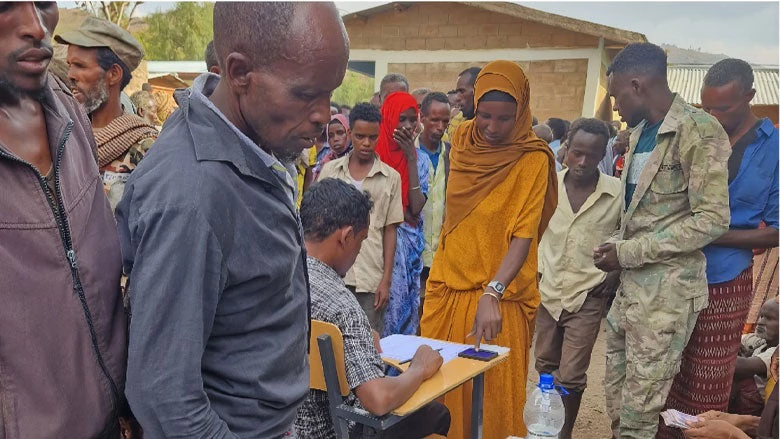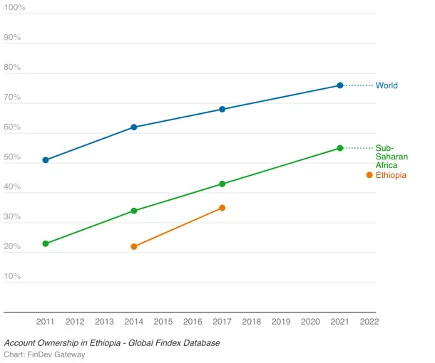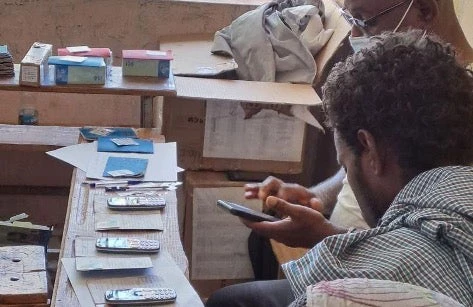From remote rural areas to bustling cities across the country, Ethiopia’s safety net programs–some of the largest in Africa–are helping more than 9 million poor and vulnerable people meet their needs and cope with multiple shocks through cash transfers. An additional benefit? Ethiopia is increasingly using electronic cash transfers for its social assistance programs, improving efficiency and transparency, and transforming lives by connecting participants with the country’s growing formal financial services.
These payments create stronger safety net programs. Electronic transfers eliminate the need for physical distribution of cash or food, increasing the speed of payments and reducing costs and the risk of theft or loss . Records generated during electronic payments also provide valuable data for reporting, monitoring, and evaluation, improving program effectiveness.
Electronic payments also have benefits for poor and vulnerable Ethiopians. Before introducing electronic payments, many of the program's recipients did not have access to formal financial services. They were often excluded from the banking system due to a lack of identification documents or proximity to bank branches. The use of e-payments creates an entry point for the unbanked population to access formal financial services, providing a secure and convenient way to save, send, and receive money. Further, existing use of bank accounts and digital platforms to deliver cash transfers could improve their resilience during shocks such as health emergencies or natural disasters.
When initiating the rural Productive Safety Net Program (PSNP) in 2005, the Ethiopian Government provided cash transfers through the regular physical cash payments. The newer Urban Productive Safety Net and Jobs Program (UPSNJP) has used electronic payments since its launch in 2016. Expanding financial inclusion
The shift to electronic cash transfer payments comes at a time of rising use of digital financial services. According to the National Bank of Ethiopia, adult Ethiopians with a bank account jumped from 22% in 2014 to about 45% in 2020. The World Bank’s Global Findex Database has also reported that Ethiopia’s financial inclusion has reached 46% as of 2022. Building on this remarkable progress, Ethiopia’s recently revised financial inclusion strategy aims for 70% of people to have a bank account by 2025. In addition to enhancing access to formal banking services and encouraging savings in these accounts, Ethiopia has strengthened financial inclusion by expanding access through bank branches and agent networks and promoting adoption of mobile money services.
Moving from a pilot to more effective and inclusive programs
Like other countries turning to electronic cash transfers, Ethiopia is leveraging social safety nets to meet its ambitious financial inclusion goals and build on momentum in reaching unbanked households . After a successful pilot in 2015 as part of the UK Department for International Development (DFID) funded Harnessing Innovation for Financial Inclusion (HiFi) program implemented by the World Bank, the rural safety net program scaled electronic payments. Although originally using mobile wallet accounts and testing biometric payment methods, the rural PNSP transitioned in 2021 to adopting the urban program’s practice of making payments into bank accounts. As of December 2022, almost 1.5 million households are receiving electronic transfers through bank accounts, including 961,185 in the rural safety net program and 411,000 in the urban safety net program.
Realizing the full potential of electronic cash transfers
Despite progress under both the rural and urban PSNPs, there are several challenges to improving e-payments. Limited cash-out locations, particularly in remote areas, make it difficult for recipients to access funds, so service providers are establishing more cash-out points. Encouraging the use of bank accounts for transactions beyond cash transfers would expand the range of available financial services and the use of the accounts beyond cash out. There are also issues with cash liquidity, limited resources at branches, and inadequate reporting from service providers. Finally, addressing infrastructure challenges, such as poor connectivity and limited access to electricity, and the need for a clear and efficient dispute resolution process would ease adoption of electronic payments.
Electronic payments using mobile wallets are an increasingly viable solution for government-to-person (G2P) payments in safety net programs. Although mobile wallets are currently constrained by an underdeveloped financial market and the need for participants to have mobile phones, network coverage, literacy, and digital literacy, recent developments such as improved telecommunications infrastructure, new regulations, and investments for "more digital" financial service providers all support increased digital finance technologies and could facilitate electronic channels for G2P payments in Ethiopia. Recognizing these emerging opportunities, the World Bank is supporting a pilot by the Government of Ethiopia with electronic payments using the Telebirr mobile money service in two selected regions.
There are also plans underway to digitalize the payment process and reporting through direct integration of the program Management Information Systems (MISs) with payment platforms to automate the cash disbursement process and reporting requirements. These changes would support all forms of e-payment.
The adoption of electronic payments for cash transfers has improved the efficiency, transparency, and accountability of social protection programs and contributed toward financial inclusion . However, there is still a long way to go to realize the full potential of e-payments to generate program efficiency, cost-effectiveness, and insightful data that informs policy and operations. Ensuring that vulnerable populations have innovative ways to access affordable and useful financial products and services – and scaling up and sustaining these electronic payments – will require collaboration between government, financial service providers, communities, and development partners. The World Bank remains committed to working alongside all stakeholders to accelerate the use of electronic payments for social safety nets and financial inclusion in Ethiopia.







Join the Conversation